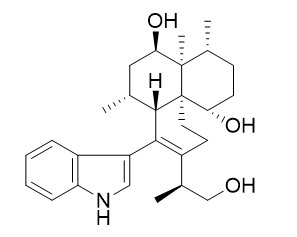Dihydroxyaflavinine
Dihydroxyaflavinine is a fungal toxin, it inhibits non-competitively GABAA receptor channel expressed in Xenopus oocytes.Dihydroxyaflavinine shows oral toxicity to the fall armyworm (Spodoptera frugiperda) and corn earworm (Heliothis zea).
Inquire / Order:
manager@chemfaces.com
Technical Inquiries:
service@chemfaces.com
Tel:
+86-27-84237783
Fax:
+86-27-84254680
Address:
1 Building, No. 83, CheCheng Rd., Wuhan Economic and Technological Development Zone, Wuhan, Hubei 430056, PRC
Providing storage is as stated on the product vial and the vial is kept tightly sealed, the product can be stored for up to
24 months(2-8C).
Wherever possible, you should prepare and use solutions on the same day. However, if you need to make up stock solutions in advance, we recommend that you store the solution as aliquots in tightly sealed vials at -20C. Generally, these will be useable for up to two weeks. Before use, and prior to opening the vial we recommend that you allow your product to equilibrate to room temperature for at least 1 hour.
Need more advice on solubility, usage and handling? Please email to: service@chemfaces.com
The packaging of the product may have turned upside down during transportation, resulting in the natural compounds adhering to the neck or cap of the vial. take the vial out of its packaging and gently shake to let the compounds fall to the bottom of the vial. for liquid products, centrifuge at 200-500 RPM to gather the liquid at the bottom of the vial. try to avoid loss or contamination during handling.
Semyung University2017, 149407
Int J Mol Sci.2021, 22(16):8641.
Antioxidants (Basel).2020, 9(7):581.
Hum Exp Toxicol.2023, 42:9603271221145386.
J of Apicultural Research2020, 10.1080
Mol Immunol. 2016, 78:121-132
Food and Fermentation Industries2019, 45(7):45-51
FARMACIA2023, Vol.71,3.
Chin Med.2022, 17(1):66.
Translational Neuroscience2024, 15:20220339
Related and Featured Products
Sheng Li Xue Bao. 1991 Jun;43(3):227-35.
Fungal toxin dihydroxyaflavinine inhibits non-competitively GABAA receptor channel expressed in Xenopus oocytes.[Pubmed:
1664974]
Dihydroxyaflavinine is an indole-derived metabolite of Aspergillus flavus.
METHODS AND RESULTS:
Its action on GABA-induced response was quantitatively studied on the GABAA receptor expressed in Xenopus oocytes after injection of chick brain mRNA under voltage-clamp conditions. Dihydroxyaflavinine inhibits GABA-induced current non-competitively with KI = 12 mumol/L. This blockage is rapidly reversible. In comparison, the inhibitory effect of penicillin on GABAA receptor is enhanced by increasing GABA concentration. Ro 15-1788 (a benzodiazepine ligand with KD = 0.6--2 nmol/L) of concentration as high as 1 mumol/L, does not mask the action of 10 mumol/L Dihydroxyaflavinine, indicating that Dihydroxyaflavinine acts on a site different from benzodiazepines.
CONCLUSIONS:
Dihydroxyaflavinine appears to expedite desensitization of the receptor, which is similar to the action of picrotoxin and in contrast with that of penicillin and bicuculline.
J Antibiot (Tokyo). 1988 Dec;41(12):1868-72.
Toxicity of selected tremorgenic mycotoxins and related compounds to Spodoptera frugiperda and Heliothis zea.[Pubmed:
3209479]
METHODS AND RESULTS:
A series of tremorgenic mycotoxins and related compounds were tested for oral toxicity to the fall armyworm (Spodoptera frugiperda) and corn earworm (Heliothis zea) by incorporation of materials into artificial diets and examining mortality and weights after 7 days. Significant mortality to both insect species was caused with Dihydroxyaflavinine and roseotoxin B, while significant mortality to H. zea was also caused by penitrem A at 25 ppm.
After 7 days, weighs of larvae treated with 25 ppm penitrem A, roseotoxin B, and verruculogen were less than 50% of controls for both insect species. Weights of H. zea larvae treated with 25 ppb of penitrem A were less than 50% those of control larvae. Relative toxicities of the tremorgens and related compounds to insects compared to vertebrates are discussed.
Isoformononetin
Catalog No: CFN95024
CAS No: 486-63-5
Price: $318/10mg
Marginatoxin
Catalog No: CFN95174
CAS No: 1422536-56-8
Price: $318/10mg
(3S,5S,E)-1,7-Diphenylhept-1-ene-3,5-diol
Catalog No: CFN95195
CAS No: 87095-75-8
Price: $318/5mg
(R)-5,3'-Dimethyl hesperidin
Catalog No: CFN95310
CAS No: N/A
Price: $318/5mg
Tumulosic acid
Catalog No: CFN95399
CAS No: 508-24-7
Price: $368/5mg
Barbaloin-related compound B
Catalog No: CFN95455
CAS No: 473225-22-8
Price: $318/5mg
12beta-Acetoxy-3,7,11,15,23-pentaoxo-lanost-8,20-dien-26-oic acid
Catalog No: CFN95505
CAS No: 1309931-91-6
Price: $318/5mg
New compound 18
Catalog No: CFN95527
CAS No: N/A
Price: $413/5mg
Ganoderiol D
Catalog No: CFN95568
CAS No: 114567-45-2
Price: $413/5mg
Tectorigenin 7-O-gentiobioside
Catalog No: CFN95577
CAS No: 67604-94-8
Price: $318/5mg



